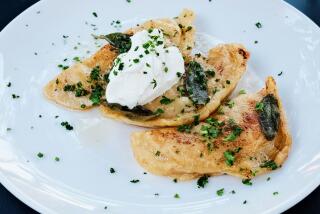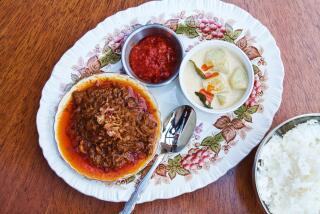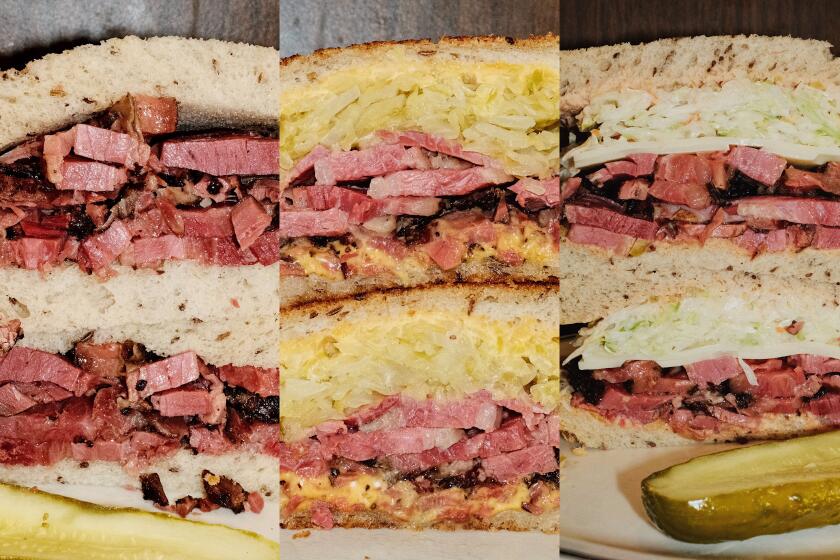For the Love of <i> Pete</i>
The Indonesian pete is a lovely thing, a bean-looking vegetable that is approximately the size of a kidney bean and the saturated green of a grasshopperŌĆÖs wing, faintly wrinkly, fading toward paleness around the perimeter.
The flavor of pete (pronounced pay-tay ) resembles that of a super-concentrated fava bean, with slight overtones of a ripe Camembert cheese and a lingering sweet-pea aftertaste. But its delicious pungency has been described by its detractors as something like a full garbage pail on a hot summer day--though perhaps in the nicest possible way. Like the spiky Southeast Asian fruit durian, pete may be harder on the nose than on the palate, and as with durian, you either love the stuff or find it hard to breathe when you are in the same room with it.
At the new West Los Angeles Indonesian restaurant Bali Place, if you order fried rice with pete , or fried noodles with pete , or shrimp sauteed with pete and hot chile sauce, this is what the waiter is likely to say: ŌĆ£Are you sure you like the stinky bean?ŌĆØ
The answer, of course, is yes.
Bali Place is a sleek, high-ceilinged cafe, all pastels, soft-hits radio, pretty blue tablecloths, just down the street from the huge Westside Pavilion, fancy enough to take your fussy aunt Jane. Late afternoons, it is jammed with Indonesian UCLA students spooning up the well-made Indonesian avocado-coffee fountain drinks; at weekend lunch, with large families scarfing fish. As at many Indonesian restaurants, the white guys are more likely to be speaking Dutch than English, and though the food at Bali Place may be less tasty than that at the famous places in Covina or Artesia, it is probably the most authentic in the area--though the large, generically pan-Indonesian menu is not particularly Balinese.
Here is the spicy, chile-fried rice you expect from an Indonesian restaurant, and here is the delicious Indonesian chow mein, bakmi goreng , slightly sweet, sauteed with garlic and chicken and bean sprouts; here are the compressed house-made rice cakes, lontong , in a thick, rich curry sweetened with coconut milk; skewers of curiously tasteless chicken satay in a sauce of ground peanuts and Indonesian sweet soy; crusty fried fish with chile; golden wedges of fried tempeh served with a little dish of fiery-hot fermented-shrimp paste.
Nasi rames , an informal version of the combination dinner better known by the politically incorrect name of rijsttafel , includes a piece of dry-ish fried chicken, a hard-boiled egg smeared with a savory chile sauce, a chunk of the chewy chile-stewed beef rendang and a bowl of creamy coconut-vegetable curry--all of which, more or less, act as condiments for a big plate of rice.
Gado gado , the popular Indonesian salad of steamed vegetables tossed with a spicy peanut dressing, is fine here, but the alternative is perhaps the best dish in the house: tahu campur , a salad of lightly fried tofu dressed with peanut and fermented shrimp sauce, tossed with vegetables and chiles, topped with a scattering of fried betel-nut chips, which brings out the subtly nutty sweetness of fresh tofu. The subtleties, though, may not be immediately apparent to the lovers of the stinky bean.
* Bali Place 2530 S. Overland Ave., West Los Angeles, (310) 204-4341. Open Thursday through Tuesday, 11:30 a.m. to 10 p.m. No alcohol. Lot parking. Takeout. MasterCard and Visa. Dinner for two, food only, $11 to $16.
More to Read
Eat your way across L.A.
Get our weekly Tasting Notes newsletter for reviews, news and more.
You may occasionally receive promotional content from the Los Angeles Times.











